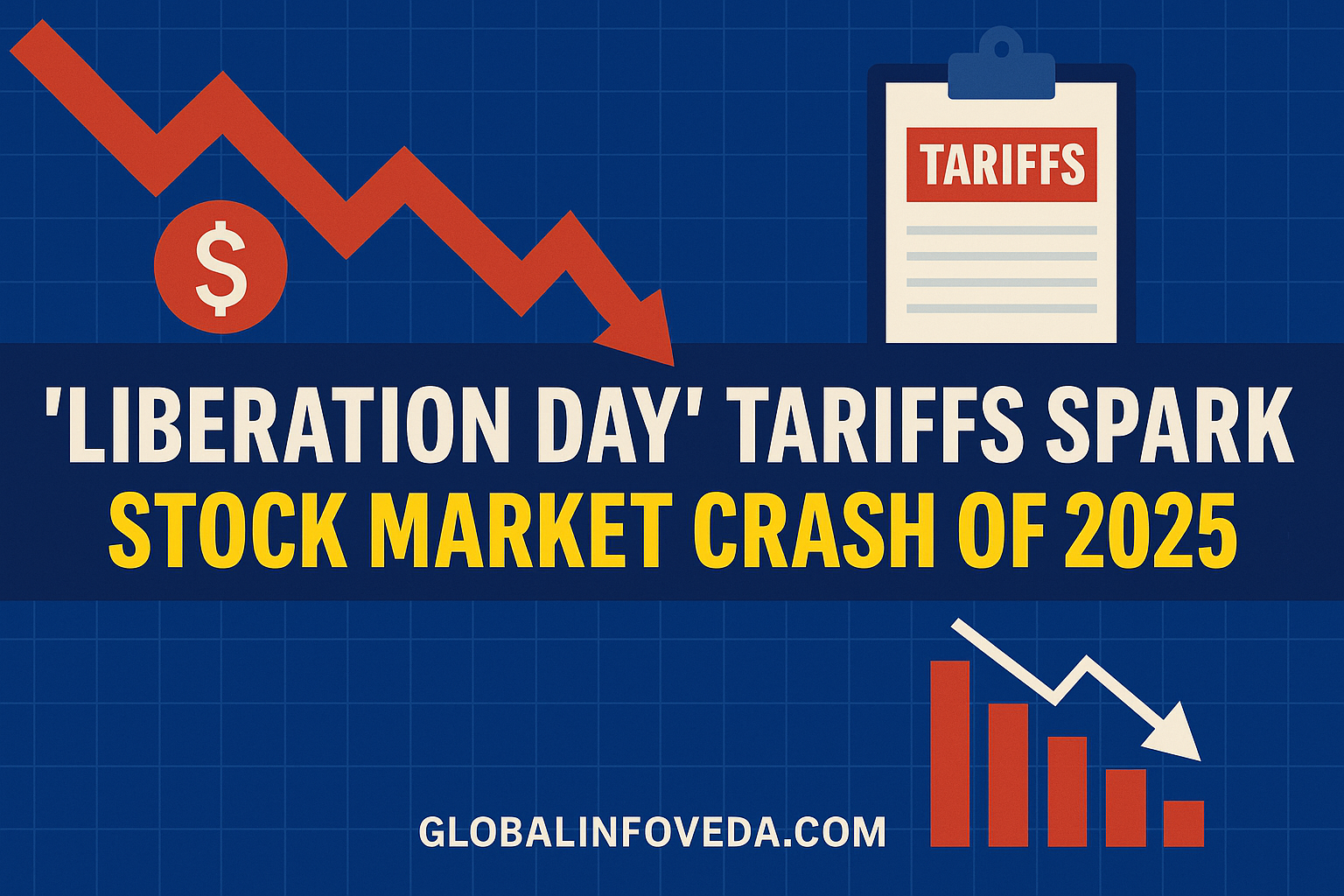“Liberation Day” Tariffs Spark Stock Market Crash of 2025
🏛️ Introduction: Shockwaves from a Policy Bombshell
On “Liberation Day”, the U.S. government announced a sweeping package of tariffs covering an unprecedented array of imports—ranging from raw materials like steel and aluminum to consumer electronics, automotive parts, and industrial machinery. Marketed as a bold step toward “economic independence,” the announcement triggered an immediate chain reaction across global markets. Within hours, the Dow Jones plunged over 3,000 points, the S&P 500 fell nearly 9%, and the NASDAQ shed more than 10%—marking its steepest one-day loss since March 2020. The VIX volatility index spiked to levels unseen in years, signaling deep investor anxiety.
Trillions in market capitalization vanished in a single trading session, eroding household wealth and sparking fears of a looming recession. This expanded analysis explores the causes of the crash, the vulnerabilities it revealed, and the broader implications for financial markets, trade policy, and the U.S. economy.
📊 Big Picture: Why the Markets Reacted So Violently
- Investor Uncertainty: Sudden, large-scale tariffs shocked markets, raising fears of a prolonged multi-front trade war.
- Corporate Earnings Risk: Rising input costs, disrupted supply chains, and anticipated retaliation threaten profitability across sectors.
- Supply Chain Breakdown: Immediate disruptions in auto, electronics, and manufacturing sectors heightened investor concerns.
- Global Growth Headwinds: Trading partners impacted by tariffs may slow production and demand, reducing U.S. export revenues.
- Capital Flight to Safety: Massive shifts into U.S. Treasuries, gold, and cash accelerated the sell-off.
📌 Context: The tariffs affect over $1.2 trillion in annual imports, touching nearly every major U.S. industry and threatening both corporate performance and consumer affordability.
🔍 Sectoral Impact: Market Casualties and Survivors
1. Technology
- Heavy dependence on imported semiconductors and components drove widespread sell-offs.
- Leading tech firms lost over $450 billion in market value within hours.
- Analysts forecast product delays, slimmer margins, and reduced R&D budgets.
2. Automotive
- Soaring material and electronics costs are expected to disrupt manufacturing schedules.
- Automaker share prices fell between 15–22%, with suppliers also posting steep losses.
3. Retail & Consumer Goods
- Reliance on imported apparel, electronics, and appliances sparked concerns about price inflation.
- Major retail chains suffered double-digit stock declines as consumer demand forecasts weakened.
4. Energy & Industrials
- Construction, manufacturing, and oilfield service companies face sharp cost increases.
- Utilities and other defensive plays saw smaller losses as investors sought safe havens.
5. Financials
- Banking stocks slumped as recession fears and potential loan defaults grew.
- M&A activity outlook dampened by market instability.
💵 Economic Impact Analysis
- Wealth Effect Shock: Losses in equities reduce consumer confidence and discretionary spending.
- Corporate Debt Stress: Higher input costs coupled with lower revenues strain balance sheets.
- Capex Retrenchment: Expansion projects are delayed or canceled to preserve liquidity.
- Recession Risk: Combined effects of higher costs, weaker demand, and financial tightening elevate recession probabilities for 2025–2026.
- Global Supply Chain Reorientation: Firms accelerate diversification away from tariffed sources, but at significant transition costs.
📈 Historical Context
- Black Monday 1987: Panic-driven selling caused a 22% market drop in one day.
- Dot-Com Bust 2000–2002: Overvaluation and sector-specific vulnerabilities triggered prolonged declines.
- COVID-19 Crash 2020: Sudden economic shutdowns and uncertainty erased trillions in market value.
- Smoot-Hawley Tariffs 1930: Aggressive protectionism deepened the Great Depression.
📊 Key Indices: One-Day Moves
| Index | Change | % Drop |
|---|---|---|
| Dow Jones | -3,042 pts | -8.9% |
| S&P 500 | -421 pts | -8.7% |
| NASDAQ | -1,459 pts | -10.1% |
| Russell 2000 | -163 pts | -9.5% |
| VIX Index | +21 pts | +74% |
🏛️ Policy & Relief Measures: Containing the Fallout
1. Monetary Policy Easing
- Federal Reserve signals readiness to cut interest rates and inject liquidity to stabilize markets.
2. Targeted Tariff Exemptions
- Waivers for critical imports in healthcare, tech, and infrastructure to avoid supply shocks.
3. Investor Confidence Campaign
- Treasury and Commerce coordinate public messaging on mitigation strategies and economic resilience.
4. Global Diplomatic Outreach
- Rapid engagement with major trade partners to limit escalation and negotiate phased tariff rollbacks.
5. Corporate Stabilization Measures
- Emergency credit lines, tax relief, and temporary subsidies for industries at highest risk.
🔮 Final Insight: A Price for Independence
The “Liberation Day” tariffs fulfill a political vision of economic sovereignty but at significant short-term economic cost. The 2025 market crash highlights the delicate balance between protectionist trade policy and global market interdependence. Without calibrated adjustments, transparent communication, and targeted relief, this pursuit of independence risks entrenching economic stagnation, weakening investor trust, and reducing America’s competitive standing.
📡 Follow GlobalInfoVeda.com for continuous coverage of trade developments and their global market implications.
